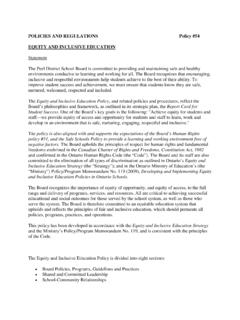Transcription of 10 Steps to Implementing Effective Inclusive …
1 Page | 1 10 Steps to Implementing Effective Inclusive practices A Guide for School Site Leaders INTRODUCTION LaSPDG is a federal grant of the Louisiana Department of Education funded by Office of Special Education Programs Page | 2 Acknowledgements This guide was developed by Kathy Kilgore, Director The SUNS Center Page | 3 Introduction Strong leadership is critical and school site leaders play a pivotal role in making Inclusive practices a reality in their schools.
2 Principals and other individuals in leadership roles must have adequate knowledge of what Inclusive practices entail and how to mobilize staff so those practices are effectively implemented. Advancing Inclusive practices in a school is not just a matter of what the school leader thinks about Inclusive practices , but how s/he actually implements those thoughts. The principal not only must believe that all students can learn, but must demonstrate this belief in everyday actions. Building collaborative relationships among staff may be challenging and requires leadership support, clarification of roles and responsibilities, and ongoing planning. Embracing the philosophy of inclusion means eliminating the focus on labels of students and making student abilities and support needs the determining factors in the provision of services and placement settings.
3 Special education teachers no longer may identify themselves as teachers of just a specific category of students. Rather, they must identify themselves as teachers of all students and be willing to provide whatever support is needed to meet the varied needs of students. Likewise, students should not be identified as self-contained or resource, but as students needing specialized instruction and supports for specific skills/subject areas for specific amounts of time in either a special education setting or a general education setting. This requires school staff to shift paradigms when determining how best to meet the needs of students with disabilities.
4 It is important that schools systematically design and implement more Effective Inclusive practices school-wide. In most instances, however, Effective Inclusive practices are not implemented without a conscious effort. It takes strong leadership to guide the process and a staff willing to establish a structured, but flexible framework in which Inclusive practices may be seamlessly integrated into the school s culture. This guide will outline ten Steps to Implementing more Effective Inclusive practices in a school. Following these Steps and Implementing with fidelity will ensure that the support needs of students with disabilities are appropriately addressed in general education settings.
5 Suggested forms for each step are indicated and included in the Appendix. These forms are provided as examples only and may be modified to meet an individual district or school needs. Page | 4 10 Steps to Implementing Effective Inclusive practices Step Topic 1 Current practices 2 Leadership Team 3 Action Planning 4 Implementation 5 Professional Development 6 Family Engagement 7 Implementation Measures 8 Monitoring Implementation 9 Revision 10 Celebrate Page | 5 Step 1: Current practices Determine Current practices It is important to ascertain what currently is in place at your school.
6 In order to move forward, you need a starting point. Data collected at this point will serve as your baseline on which to measure success during the school year. First, determine what Inclusive practices are already being implemented. For example, collect the following data/information: How many students with disabilities (SWD) are currently included in general education classes? Relative to performance standards, how are your SWD performing? How are SWD scheduled into general education classes? Based on numbers? Based on needs? How are SWD in general education classes supported in those classes? Are any of your special education teachers co-teaching?
7 If so, what approaches are they using? Do special education and general education teachers who share instructional responsibilities for the same students have joint planning time? How many of your general education teachers are Implementing high quality differentiated instructional strategies? Are there a variety of interventions available at each tier of your RtI process? What resources are available (instructional coaches, mentors, special programs) to help meet the support needs of SWD? It is also crucial to inventory staff to determine what they currently know about Inclusive practices and their level of readiness for implementation. For example, determine the following: How do staff members define inclusion ( , Inclusive practices )?
8 What is their definition? What do staff members currently know about Inclusive practices ? Collaborative Teaching Support Models, co-teaching approaches, scheduling SWD based on support needs? Are staff members currently Implementing any Inclusive practices models? Co-teaching, Consultancy, Paraeducator? If so, how are they are working? Are staff members willing to engage in Implementing more Inclusive practices such as co-teaching? Information from a staff inventory will identify which staff needs additional professional development. It also will identify staff that may serve as mentors to other staff. Also, if the school is just beginning to use the co-teaching model, then a staff inventory will identify which staff members are willing to co-teach.
9 Conducting a needs assessment and staff inventory will provide a snapshot of what is occurring at the school at the present time. This information/data will help direct future actions. It also will provide baseline data on which to measure progress as you begin Implementing a more structured approach to the provision of Inclusive practices . Page | 6 Step 2: Leadership Team Establish an Inclusive practices Leadership Team An Inclusive practices Leadership Team addresses the overall implementation of Inclusive practices across the entire school.
10 The team should be made up of the individuals within the school who function as leaders. The team does not have to be a new team; an existing leadership team may simply take on the function of an Inclusive practices Leadership Team. This team should identify a set of principles and beliefs that will govern a school-wide Inclusive focus. Principles and beliefs should include: All students can learn (even if not in the same way nor within the same timelines); All students have a right to quality instructional programs that help them progress; All students belong to all staff (all staff taking ownership for all students); and Everyone (administrators, teachers, paraeducators, support staff, cafeteria staff, custodians, security, clerical, etc.)








